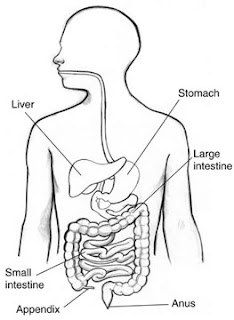The Inflamed Appendix
Appendicitis is the medical term for the inflammation of the appendix. The appendix is a fingerlike pouch attached to the first part of the large intestine called cecum. It is located in the lower right area of the abdomen.
Although anyone can get appendicitis, it is more common among people aged 10 to 30 years old.
Experts are not sure what the appendix does, if anything. The removal of the appendix does not seem to affect a person’s health. The inside portion of the appendix is called the appendiceal lumen. The mucus that the appendix creates travel through the appendiceal lumen and empties into the large intestine.
 Causes
Causes
Appendicitis is commonly caused by obstruction of the appendix’x lumen. This can cause bacteria that normally live inside the appendix to multiply. As a result, the appendix becomes infected and become swollen. Obstruction of the appendix can be caused by
feces, parasites, or growths that clog the appendiceal lumen
enlarged lymph tissue in the wall of the appendix, caused by infection in the gastrointestinal tract or elsewhere in the body
inflammatory bowel disease, including Crohn’s disease and ulcerative colitis
trauma to the abdomen
There is danger of the inflamed appendix to burst. When this happens, the infection can spread to nearby organs in the abdomen—a condition called peritonitis. This is a potentially dangerous condition, which requires immediate medical care.
Symptoms of Appendicitis
The most common symptom of appendicitis is pain in the abdomen. The abdominal pain usually
occurs suddenly, often causing a person to wake up at nightOther symptoms of appendicitis may include
occurs before other symptoms
begins near the belly button and then moves lower and to the right
is new and unlike any pain felt before
gets worse in a matter of hours
gets worse when moving around, taking deep breaths, coughing, or sneezing
loss of appetiteDiagnosis of Appendicitis
nausea
vomiting
constipation or diarrhea
inability to pass gas
a low-grade fever that follows other symptoms
abdominal swelling
the feeling that passing stool will relieve discomfort
A doctor or other health care provider can diagnose most cases of appendicitis by taking a person’s medical history and performing a physical examination. If a person shows classic symptoms, a doctor may suggest surgery right away to remove the appendix before it bursts.
Doctors may use laboratory and imaging tests, such as blood tests, computed tomography (CT) scans, and abdominal x ray to confirm appendicitis if a person does not have classic symptoms. Tests may also help diagnose appendicitis in people who cannot adequately describe their symptoms, such as children or the mentally impaired.
Treatment of Appendicitis
Surgery
Typically, removing the appendix treats appendicitis. If appendicitis is suspected, a doctor will often suggest surgery without conducting extensive diagnostic testing. Prompt surgery decreases the likelihood the appendix will burst.
Surgery to remove the appendix is called appendectomy and can be done two ways. The older method, called laparotomy, removes the appendix through a single incision in the lower right area of the abdomen. The newer method, called laparoscopic surgery, uses several smaller incisions and special surgical tools fed through the incisions to remove the appendix. Laparoscopic surgery leads to fewer complications, such as hospital-related infections, and has a shorter recovery time.
Surgery occasionally reveals a normal appendix. In such cases, many surgeons will remove the healthy appendix to eliminate the future possibility of appendicitis. Occasionally, surgery reveals a different problem, which may also be corrected during surgery.
Sometimes abscess forms around a burst appendix—called an appendiceal abscess. An abscess is a pus-filled mass that results from the body’s attempt to keep an infection from spreading. An abscess may be addressed during surgery or, more commonly, drained before surgery. To drain an abscess, a tube is placed in the abscess through the abdominal wall. CT is used to help find the abscess. The drainage tube is left in place for about 2 weeks while antibiotics are given to treat infection. Six to 8 weeks later, when infection and inflammation are under control, surgery is performed to remove what remains of the burst appendix.
Nonsurgical Treatment
Nonsurgical treatment may be used if surgery is not available, if a person is not well enough to undergo surgery, or if the diagnosis is unclear. Some research suggests that appendicitis can get better without surgery. Nonsurgical treatment includes antibiotics to treat infection and a liquid or soft diet until the infection subsides. A soft diet is low in fiber and easily breaks down in the gastrointestinal tract.
Recovery
With adequate care, most people recover from appendicitis and do not need to make changes to diet, exercise, or lifestyle. Full recovery from surgery takes about 4 to 6 weeks. Limiting physical activity during this time allows tissues to heal.
Suggested Readings:
View all Digestive Diseases Topics
Source: National Digestive Diseases Information Clearinghouse (NDDIC), a service of the National Institute of Diabetes and Digestive and Kidney Diseases (NIDDK). NIH Publication No. 09–4547, November 2008
Page Last Revised: December 4, 2010
[Top of Page]
